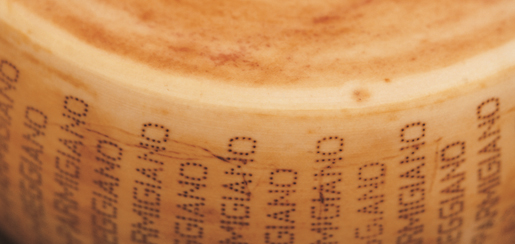Parmigiano Reggiano
Parmigiano Reggiano is a hard straw coloured cheese made from raw cow’s milk. It is commonly used as an ingredient in grated form but is also wonderful to eat on its own in small pieces or shavings. Parmigiano isn’t salty but is ‘umami’ meaning savoury – this is due to the amino acids breaking down in the slow maturation. Foods such as these act as flavour enhancer to other foods which is why it is used so frequently in Italian cooking. It is a very healthy, vitamin-packed cheese which gives you a “buzz” of energy when eaten, so much so that some people say it is an aphrodisiac. It is easily digested due to the amino acids present and it can actually help other foods to be digested more easily too.
The cows that provide the milk are kept in strictly controlled environments, often inside and are fed on grass or hay primarily, concentrated feeds have to be prepared with a list of specific ingredients.
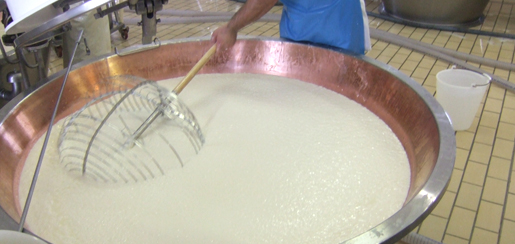
Production of Parmegiano-Reggiano is exclusive to the provinces of Parma, Reggio Emilia and Modena and Bologna (on the left side the Reno river) and Mantua (on the right bank of the Po River). It is a PDO under European Union regulations meaning Protected Designation of Origin so to be Parmigiano Reggiano it has to come from these particular areas and be made by approved rules.
There are approximately 3,900 dairy farmers round the hills and valleys of Parmigiano-Reggiano that supply the milk to around 420 “caseifici” or cheese factories where the wheels of Parmigiano-Reggiano are made. The traditional methods for making cheese are safeguarded by Consorzi o of Parmigiano-Reggiano. These methods, some staying the same for over nine centuries, may not be time or cost efficient but ensure that their cheeses are made to the highest quality, using the best milk in each area. This helps explain the cost of these cheese.
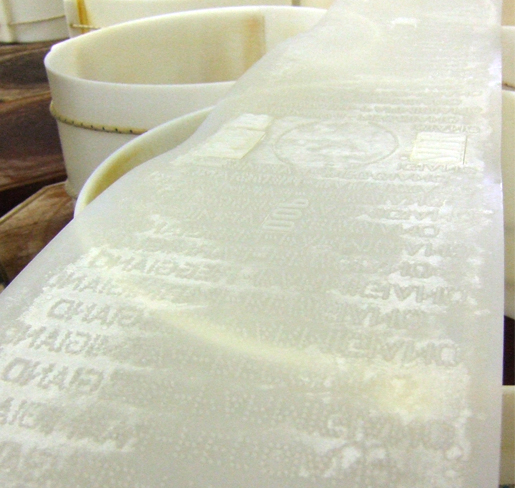
Morning and evening milk
Parmigiano Reggiano is made from a combination of morning and evening milking. The evening milk separates naturally overnight allowing for part of the cream to be skimmed off. The milk is then mixed with the morning whole milk and the whey from the previous day in heated copper cauldrons. After the addition of with rennet; it is churned and left to coagulate. The solid mixture, the curd, is then broken up in grains and then it is whisked and heated. The grains are collected in large sheets of cheesecloth to become the cheese. This is lifted to allow the liquid whey to be drained off.
As with the tradition of the original shepherds they make a sign of the cross on the cheese at this stage almost to bless it and wish it on its’ way to becoming a ‘good’ Parmigiano-Reggiano (to produce a dodgy cheese wastes a lot of money!).
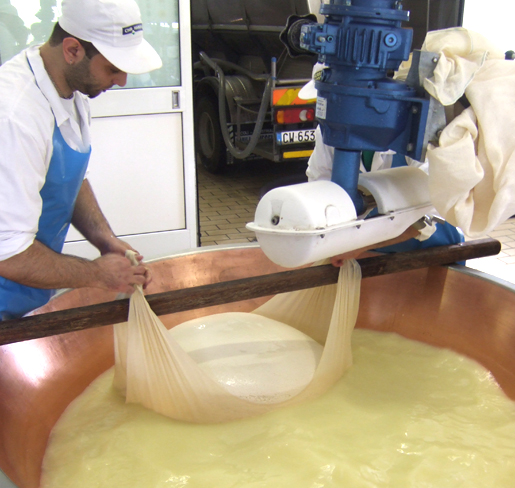
The mass of curds is divided into two pieces: these are called twin cheeses. Each one is wrapped in cheesecloth and placed in a circular mould called a “fascera”. In the afternoon, the cheesecloth is removed and a special plastic stamp is inserted between the cheese and the inside of the mould. The stamp forms a number of impressions on the sides of the wheel, denoting the number of the caseificio, the production month and year and the pin dots that form the words Parmigiano-Reggiano.
After a couple of days the mould is peeled off, leaving the precious embossed name of ‘Parmigiano Reggiano’ . After resting a few days in a steel mould, the cheese is given a bath in salty water for 20-25 days before being taken to the enormous rooms where the wheels are aged. Each cheese, and there could be thousands in one room, has to be cleaned and turned manually or robotically every 7 days.
Listen to your cheese
It is during this time when my favourite stage of the process occurs. ‘I battitori’ emerge, men who have been training for two years to test the quality of the cheese by beating it with little hammers and listening to the sound it makes. I couldn’t help thinking it must be repetitive and that they long for one to be a bit wonky sounding so that they can show off their skills and say “mamma mia, we have a dud one over here, come and listen!” Reject cheeses have their names scored off the outside so that they cannot be sold under the name Parmigiano-Reggiano.
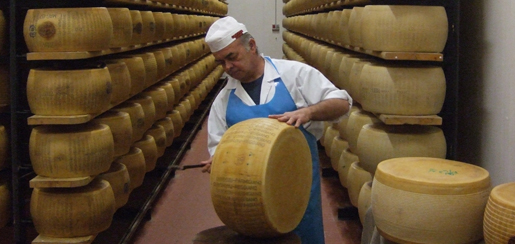
Each wheel of the Parmigiano-Reggiano is aged for the minimum of 12 months, at this stage the young cheese has a mild and milky flavour. They weigh approximately 39 kilos each. The most popular ages are 24 and 28 months when they have reached the perfect ages to be eaten. Cheese enthusiasts describe the flavour at this point as melted butter inside and the crust of the cheese as dry fruits and nutmeg. I tasted young Parmigiano-Reggiano, softer and less crumbly than its older sister. I thought it delicious and don’t know why it is not available here. On the other end of the scale, an equally delicious but completely different three-year old cheese is full-flavoured and fruity with a creamy crumbliness. I think we are so used to eat this cheese as an ingredient it is worth seeking out the different ages of maturity and tasting them on their own.
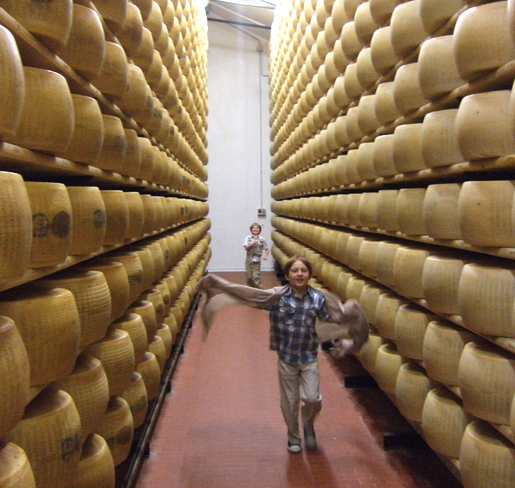
Katie’s Tips
- Always buy Parmigiano Reggiano fresh from the block and grate it yourself rather than buy the ready-grated kind.
- How to store it – wrap it tightly in baking parchment, muslin or cling film.
- Another tip is: Don’t think of it just for cooking, children in Italian nurseries are given little lumps of cheese as snacks. It gives energy and sustains their appetite until lunchtime.
- Try pouring a rich aged balsamic vinegar over small pieces of cheese and passing them round with glasses of red wine.
- Keep the rinds that cannot be grated easily and put them into stocks for extra flavouring. They won’t melt but will add a wonderful flavour.
- Another great tip is if you scratch off the very outer layer of cheese so that the spotted name disappears you can grate all the rest and therefore not waste any of it. Mix the harder grated cheese with the softer part from the centre so as the tastes will differ.
- There is a special knife for cutting Parmesan called a “coltellino a mandorla” due to the almond shape of the blade. It is perfect for breaking the cheese and digging it out rather than slicing through it.
